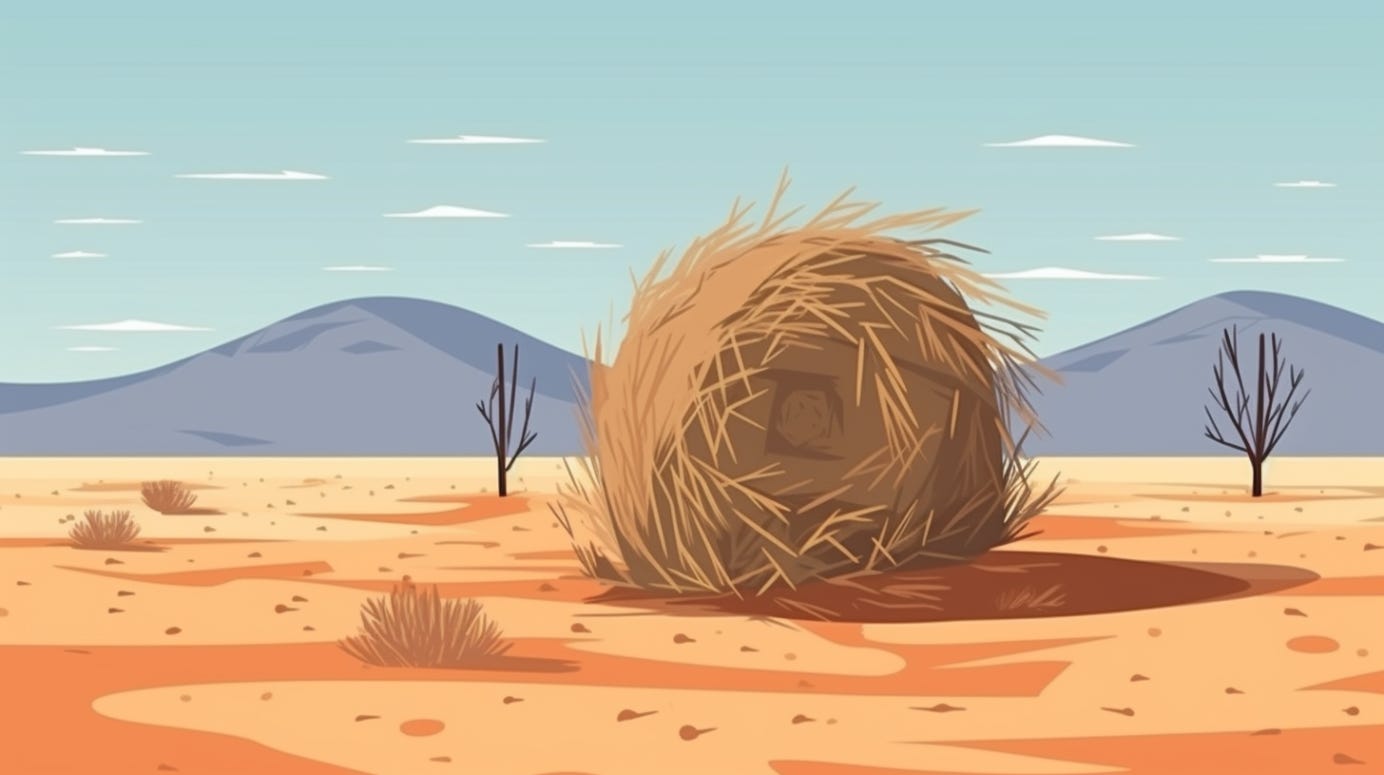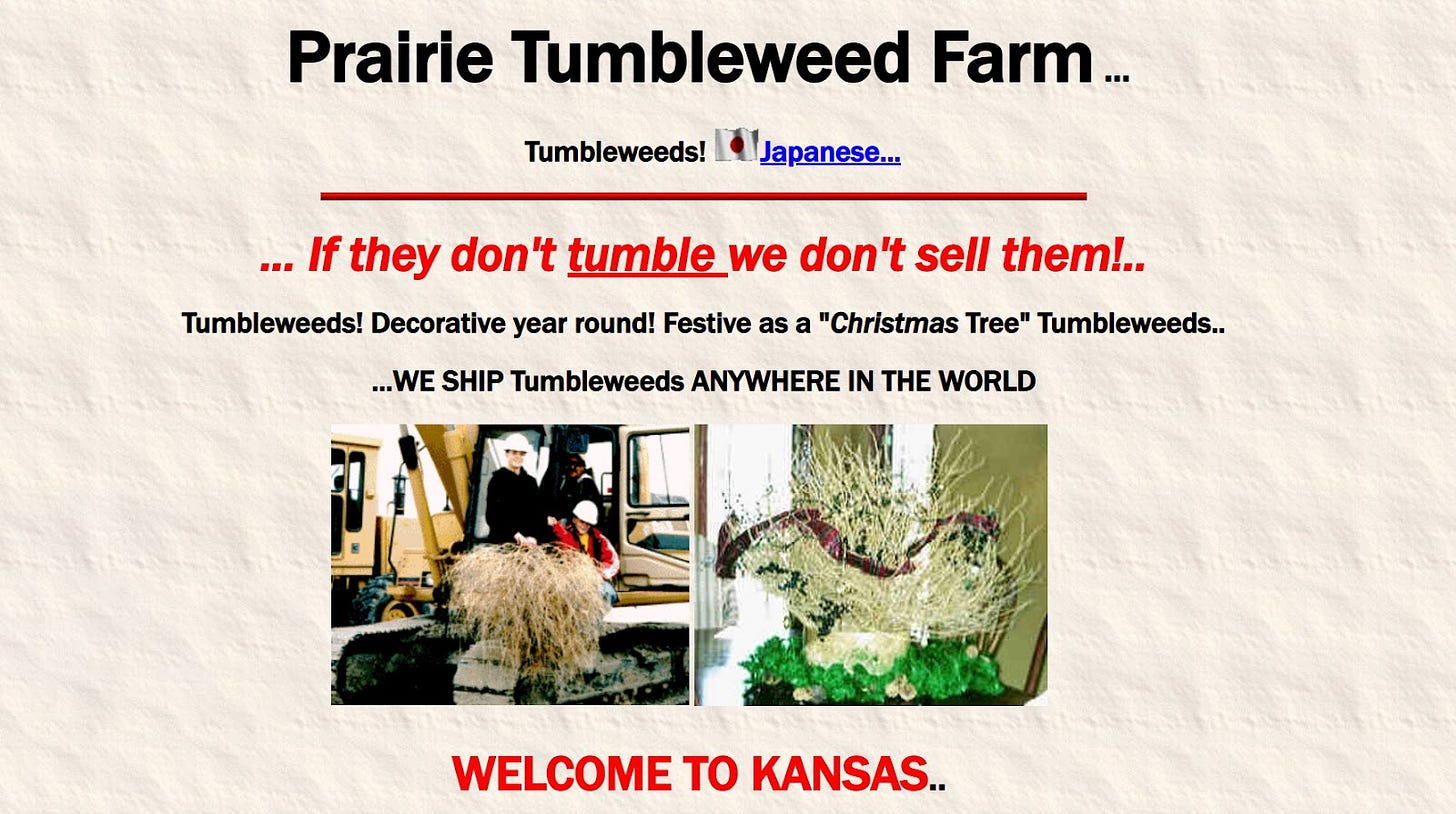Before Amazon, Google, and eBay, Linda Katz Started An Online Tumbleweed Empire… On Accident
“It’s hard to turn down $25 for a weed blowing past your house”
Tumbleweed noun
tum·ble·weed
: a plant that breaks away from its roots in the autumn and is driven about by the wind as a light rolling mass
The internet arrived in Garden City, Kansas, in 1992, Linda Katz recalls. At the time, the town had a population of around 22,000 people, and she was one of the very first to sign up for internet access. It was new, and nobody quite knew what to make of it.
“I was like the seventh person on the internet here,” Katz, now 71, tells me over the phone. “I wanted to learn how to make a web page.”
In the months that followed, Katz would become one of the internet’s first entrepreneurs. She’d go on to ship her product to all corners of the United States and even the world as orders poured into her website, Prairie Tumbleweed Farm.
The same website that she made as a joke to amuse her family.
A Farm On The Prairie
Prairie Tumbleweed Farm never actually existed, but you’d never know it from the website that Katz built. It’s decidedly 90s, but packed with information on the farm, tumbleweeds, and her “employees.”
“If they don’t tumble, we don’t sell them!” the farm’s motto splashed across the page in bright red lettering. “Garden City, Kansas… Tumbleweed Capital of the World!”
There were photos, too, showing some young tumbleweed farmers hard at work, using heavy equipment to gather their quarry.
“I got some hardhats from my brother and my neighbor owned heavy equipment, like excavators and things like that,” Katz says, stifling laughter. “I staged my nieces and nephews with tumbleweeds around all this heavy equipment and made up this… farm. Prairie Tumbleweed Farm.”
She gave the kids lofty titles like Treasurer, Head of Personal Relations, and Manager of Operations, to give her family an extra giggle. Nobody else was going to see it, after all, so it could be as silly as she wanted it to be.
“I took the pictures and I posted the site on the internet,” she says. “It was just a joke.”
A Western Bride and Barney the Dinosaur
Katz published her website and hosted it through Yahoo, allowing it to appear in search results. She shared it with her friends and family, but they weren’t the only ones who caught wind of Prairie Tumbleweed Farms.
“About a week after I put it online I got an email from a bride in New Jersey,” Katz explains. “She wanted to have a western-themed wedding, so we had to send her two tumbleweeds.”
“I kind of laughed. I thought ‘Well, I can do this,’” Katz recalls. At the time, the US Postal Service emphasized weight over physical dimensions, so shipping a tumbleweed was cheap. The tumbleweeds themselves were plentiful. “I live on the prairie, so I went out in my backyard, got two tumbleweeds, boxed them up, and shipped them off.”
But the first order wasn’t a fluke, and the second email that rolled into Prairie Tumbleweed Farm was a pretty big deal. A big purple deal, actually.
“My second order was from Barney & Friends. They wanted to do a whole thing about tumbleweeds, so they wanted seven of them. I thought ‘Why would anyone want a tumbleweed?’,” Katz laughs. “But okay.”
That’s a Prairie Tumbleweed Farm tumbleweed.
Shipping a tumbleweed was easy, but there were still some tricks to learn. Opening the top and bottom of the box so that the tumbleweed can be pulled through (rather than pushed down) is the best method, Katz says. This keeps the tumbleweed in the best shape and causes the least damage.
Katz began charging $15 for a small tumbleweed and $25 for larger ones. Special orders were sometimes more.
Occasionally, customers requested massive tumbleweeds which could only be shipped in a washing machine box. Katz always obliged.
A 9-Year-Old’s Memory
Katz tells me that she created the website on a lark, and purely as a joke, but the idea behind it was brewing in her head for decades. As a 9-year-old girl living in a much smaller version of Garden City, Kansas, she saw something that stuck with her for the rest of her life.
“It was the 4th of July and we were at a roadside park with my parents and we were watching the fireworks,” Kats recalls. “A family in a station wagon drove by. They parked and a lady got out and grabbed a tumbleweed and put it in the back of the car. The car had New York State plates on it, and I thought it was so unusual. I mean who would want a tumbleweed?”
Many years later, as she was exploring the world wide web for the very first time, that memory came back to her, and it would be the inspiration for a joke-turned-business that Katz enjoyed for almost 20 years.
Booming Business
Prairie Tumbleweed Farm was an undeniable hit within months of its debut. Katz was fielding orders from all over the world, even translating the site into Japanese to broaden its reach.
She provided tumbleweeds for some big-name Hollywood movies, like Finding Neverland starring Johnny Depp and Kate Winslet. Her tumbleweeds ended up in other movies, too, but the people ordering them would rarely reveal the names, insisting that the films didn’t yet have working titles.
Advertisers got in on it, too.
“There was this car commercial. It was this really pretty girl standing beside a car, holding up a tumbleweed,” Katz laughs. “I have no idea what the concept on that was.” Ralph Lauren retail stores ordered from her, too, as did Pottery Barn.
NASA, which was working on a “Tumbleweed Rover” at the time, bought a bunch of tumbleweeds for testing and research. The NASA website boasted that Prairie Tumbleweed Farm was their exclusive tumbleweed supplier.
Prairie Tumbleweed Farm was a one-in-a-million side hustle, raking in as much as $40,000 per year for Katz and her family.
Schools often requested tumbleweeds for educational purposes. Katz always sent those for free.
To ensure that she always had enough to meet demand, she stockpiled an inventory of the dry plants during fall, loading up a horse trailer and storing them for winter orders.
Unfortunately, the mythical farm would run into a problem that many modern e-commerce companies still struggle with: shipping costs.
The End Of An Era
After more than a decade in business, the US Postal Service — Katz’s preferred shipper — threw her a curveball. Rather than charging primarily by weight, which meant just a few bucks for a massive box that contained mostly air and some dry plant material, they started prioritizing space.
Charging by dimension meant that while Katz might only be charging $25 for a large tumbleweed, it could cost upwards of $50 or even $100 to ship it. Large orders that required many individual plants were exponentially more costly to ship.
This, combined with her young helpers growing up and embarking on their own careers, spelled the end for Prairie Tumbleweed Farm.
But Katz doesn’t mourn the end of the business, instead choosing to look back on it fondly as a project that brought her and her family even closer together.
“It was a lot of fun,” Katz says. “We sent ‘em all over the world.”
If you enjoyed this article, you should probably subscribe, right? I like writing about offbeat, interesting, and underreported stories, and if you like reading them, we seem like a perfect match.
Oh, and if you REALLY liked it, why not share it with your friends, family, and followers? ❤️
You’re the best!










Such a cool story! A happy new subscriber here, keep it up :))